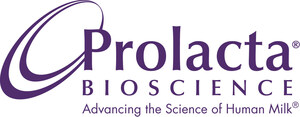DUARTE, Calif., March 17, 2021 /PRNewswire/ -- Four clinical studies, including a randomized clinical trial, showed that an exclusive human milk diet (EHMD) using Prolacta Bioscience's 100% human milk-based fortifiers reduced the incidence and/or severity of retinopathy of prematurity (ROP) in premature infants compared to those fed cow milk-based fortifiers.
ROP is an eye disease that results in abnormal development of retinal blood vessels and is a leading cause of decreased vision and blindness in children worldwide, primarily affecting premature infants.1,2 Severe ROP is a predictor of functional disability for children,3 including a direct impact on their neurodevelopment.4
"We are encouraged by the growing body of clinical evidence proving the significant health benefits of Prolacta's products as part of an EHMD and are especially encouraged by this data, which shows reduction in the incidence and severity of ROP," said Melinda Elliott, M.D., FAAP, and chief medical officer of Prolacta. "Addressing premature infant complications through nutrition in the neonatal intensive care unit (NICU) means improved short- and long-term health benefits for each infant affected, as well as reduced hospitalizations and costs for all involved."
ROP is one of the comorbidities of prematurity that hospitals worldwide are working to reduce. The incidence and/or severity of this life-changing disease decrease when extremely premature infants are nourished with Prolacta's products as part of an EHMD.5-8
Clinical Evidence
- Results of a 2018 study showed an 84% relative reduction in the incidence of severe ROP (P = 0.04) in preterm infants receiving Prolacta's products as part of an EHMD when compared to preterm infants < 1,250 g receiving mother's own milk/donor milk with cow milk-based fortifiers.6
- Similarly, a 2016 study showed a 55% relative reduction in the incidence of ROP (P < 0.001) in preterm infants ≤ 1,500 g receiving Prolacta's fortifiers as part of an EHMD when compared to preterm infants receiving cow milk-based fortifiers.8
- By implementing Prolacta's products as part of an EHMD, a 2016 study showed multiple clinical outcome improvements, including a 42% relative reduction in the incidence of ROP (P = 0.003), in preterm infants < 1,250 g.7
- The University of Virginia (UVA) NICU achieved a 22% relative reduction in the incidence of ROP (P = 0.054) after implementing Prolacta's products as part of an EHMD in infants born ≤ 1,250 g.5
About Prolacta Bioscience
Prolacta Bioscience® Inc. is a privately held, global life sciences company dedicated to Advancing the Science of Human Milk® to improve the health of premature and critically ill infants. Prolacta's 100% human milk-based nutritional products have been evaluated in more than 20 clinical trials published in peer-reviewed journals. More than 63,000 premature infants have benefitted from Prolacta's nutritional products worldwide to-date.9 Established in 1999, Prolacta is the world's leading provider of human milk-based nutritional products for hospital use and is also exploring the therapeutic potential of human milk across a wide spectrum of diseases. Prolacta maintains the industry's strictest quality and safety standards for screening, testing, and processing human donor milk. Operating the world's first pharmaceutical-grade human milk processing facilities, Prolacta uses vat pasteurization and a patented, FDA-reviewed manufacturing process to ensure pathogen inactivation, while protecting the nutritional composition and bioactivity of its human milk-based products. Prolacta headquarter is located at Duarte, California, and can be found online at www.prolacta.com, on Twitter, Instagram, Facebook and LinkedIn.
Media Contact:
Loren Kosmont
[email protected]
310.721.9444
References
- Dutta S, Raghuveer T, Vinekar A, Dogra MR. Can we stop the current epidemic of blindness from retinopathy of prematurity? Indian Pediatr. 2016;53(Suppl 2):S80-S84.
- Kong L, Fry M, Al-Samarraie M, Gilbert C, Steinkuller PG. An update on progress and the changing epidemiology of causes of childhood blindness worldwide. J AAPOS. 2012;16(6):501-507. doi:10.1016/j.jaapos.2012.09.004
- Raghuveer TS, Zackula R. Strategies to prevent severe retinopathy of prematurity: a 2020 update and meta-analysis. NeoReviews. 2020;21(4):e249-e263. doi:10.1542/neo.21-4-e249
- Molloy CS, Anderson PJ, Anderson VA, Doyle LW. The long-term outcome of extremely preterm (<28 weeks' gestational age) infants with and without severe retinopathy of prematurity. J Neuropsychol. 2016;10(2):276-294. doi:10.1111/jnp.12069
- Delaney Manthe E, Perks PH, Swanson JR. Team-based implementation of an exclusive human milk diet. Adv Neonatal Care. 2019;19(6):460-467. doi:10.1097/ANC.0000000000000676
- O'Connor DL, Kiss A, Tomlinson C, et al. Nutrient enrichment of human milk with human and bovine milk-based fortifiers for infants born weighing <1250 g: a randomized clinical trial [published corrections appear in Am J Clin Nutr. 2019;110(2):529 and Am J Clin Nutr. 2020;111(5):1112] Am J Clin Nutr. 2018;108(1):108-116. doi:10.1093/ajcn/nqy067
- Hair AB, Peluso AM, Hawthorne KM, et al. Beyond necrotizing enterocolitis prevention: improving outcomes with an exclusive human milk-based diet [published correction appears in Breastfeed Med. 2017;12(10):663] Breastfeed Med. 2016;11(2):70-74. doi:10.1089/bfm.2015.0134
- Assad M, Elliott MJ, Abraham JH. Decreased cost and improved feeding tolerance in VLBW infants fed an exclusive human milk diet. J Perinatol. 2016;36(3):216-220. doi:10.1038/jp.2015.168
- Estimated number of premature infants fed Prolacta's products from January 2007 to August 2020; data on file.
SOURCE Prolacta Bioscience

Related Links
WANT YOUR COMPANY'S NEWS FEATURED ON PRNEWSWIRE.COM?
Newsrooms &
Influencers
Digital Media
Outlets
Journalists
Opted In





Share this article